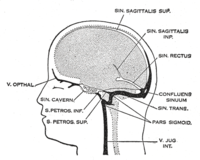
Spontaneous Intracranial Hypotension: Imaging in Diagnosis and Treatment.
Sign Up to like & getrecommendations! Published in 2019 at "Radiologic clinics of North America"
DOI: 10.1016/j.rcl.2018.10.004
Abstract: This article reviews the role of imaging in the diagnosis, management, and treatment of spontaneous intracranial hypotension (SIH). SIH is a debilitating and often misdiagnosed condition caused by either a spinal cerebrospinal fluid (CSF) leak… read more here.
Keywords: intracranial hypotension; imaging diagnosis; treatment; myelography ... See more keywords

Transient Acute Hydrocephalus After Spontaneous Intracranial Bleeding in Adults.
Sign Up to like & getrecommendations! Published in 2017 at "World neurosurgery"
DOI: 10.1016/j.wneu.2016.12.103
Abstract: BACKGROUND Acute hydrocephalus (AH) is commonly encountered after spontaneous or traumatic intracranial bleeding in adults. In the setting of AH, external ventricular drainage is usually proposed as the urgent management. But in rare occasions, AH… read more here.
Keywords: bleeding; acute hydrocephalus; bleeding adults; intracranial bleeding ... See more keywords

Spontaneous Intracranial Hypotension: A Review and Introduction of an Algorithm For Management.
Sign Up to like & getrecommendations! Published in 2017 at "World neurosurgery"
DOI: 10.1016/j.wneu.2017.01.123
Abstract: BACKGROUND Spontaneous intracranial hypotension (SIH) is a condition of low cerebrospinal fluid volume and pressure caused by a leak of cerebrospinal fluid through a dural defect. Diagnosis and management can be difficult, often requiring coordination… read more here.
Keywords: management; intracranial hypotension; spontaneous intracranial; hypotension review ... See more keywords

Imaging Classification and Treatment of Spontaneous Intracranial Fusiform and Dissecting Aneurysms.
Sign Up to like & getrecommendations! Published in 2017 at "World neurosurgery"
DOI: 10.1016/j.wneu.2017.07.090
Abstract: LETTER: We read with great interest the article by Zhang et al. 1 titled “Endovascular Treatment of Spontaneous Intracranial Fusiform and Dissecting Aneurysms: Outcomes Related to Imaging Classification of 309 Cases.” We appreciate the authors’… read more here.
Keywords: imaging classification; fusiform dissecting; dissecting aneurysms; treatment spontaneous ... See more keywords

Repeated Spontaneous Intracranial Epidural Hemorrhage After Hysterical Crying.
Sign Up to like & getrecommendations! Published in 2018 at "World neurosurgery"
DOI: 10.1016/j.wneu.2018.03.028
Abstract: BACKGROUND Spontaneous epidural hemorrhage (EDH) is a rare occurrence that may be caused by vascular anomalies, infections, coagulopathies, or tumors. Spontaneous EDH occurring in patients without specific underlying disease has been reported only as intraspinal… read more here.
Keywords: epidural hemorrhage; hysterical crying; repeated spontaneous; edh ... See more keywords

Epidural Blood Patch as a diagnostic and therapeutic intervention in Spontaneous Intracranial Hypotension - a novel approach to management.
Sign Up to like & getrecommendations! Published in 2020 at "World neurosurgery"
DOI: 10.1016/j.wneu.2020.01.163
Abstract: OBJECTIVE Spontaneous Intracranial Hypotension (SIH) remains a diagnostic and therapeutic challenge. Non-specific clinical features and a reluctance to treat without confirmatory imaging evidence undermine management. Investigations are often insensitive, expensive with many patients continuing to… read more here.
Keywords: intracranial hypotension; diagnostic therapeutic; blood patch; epidural blood ... See more keywords

Spontaneous intracranial hypotension: searching for the CSF leak
Sign Up to like & getrecommendations! Published in 2022 at "The Lancet Neurology"
DOI: 10.1016/s1474-4422(21)00423-3
Abstract: Spontaneous intracranial hypotension is caused by loss of CSF at the level of the spine. The most frequent symptom of this disorder is orthostatic headache, with the headache worsening in the upright position and subsiding… read more here.
Keywords: csf leak; searching csf; spontaneous intracranial; intracranial hypotension ... See more keywords

Spontaneous intracranial hypotension: from cerebral venous thrombosis to neurosurgical treatment: a case series experience from a Brazilian tertiary health care center
Sign Up to like & getrecommendations! Published in 2022 at "Arquivos de Neuro-Psiquiatria"
DOI: 10.1055/s-0042-1758752
Abstract: Abstract Background Spontaneous intracranial hypotension (SIH) is a secondary cause of headache and an underdiagnosed disease. The clinical presentation can be highly variable. It typically presents with isolated classic orthostatic headache complaints, but patients can… read more here.
Keywords: neurosurgical treatment; neurology; venous thrombosis; cerebral venous ... See more keywords

Behavioral Variant Frontotemporal Dementia as a Serious Complication of Spontaneous Intracranial Hypotension.
Sign Up to like & getrecommendations! Published in 2018 at "Operative neurosurgery"
DOI: 10.1093/ons/opy029
Abstract: BACKGROUND Behavioral variant frontotemporal dementia (bvFTD) is a devastating early onset dementia. Symptoms of bvFTD may be caused by spontaneous intracranial hypotension (SIH), a treatable disorder, but no comprehensive study of such patients has been… read more here.
Keywords: bvftd; frontotemporal dementia; dementia; behavioral variant ... See more keywords

A nomogram to predict cognitive impairment after supratentorial spontaneous intracranial hematoma in adult patients
Sign Up to like & getrecommendations! Published in 2019 at "Medicine"
DOI: 10.1097/md.0000000000017626
Abstract: Supplemental Digital Content is available in the text read more here.
Keywords: predict cognitive; nomogram predict; impairment supratentorial; supratentorial spontaneous ... See more keywords

Variables affecting the presence of occult cerebral microbleeds and subsequent spontaneous intracranial haemorrhage in adult patients with severe thrombocytopenia
Sign Up to like & getrecommendations! Published in 2021 at "British Journal of Haematology"
DOI: 10.1111/bjh.17500
Abstract: Severe thrombocytopenia (platelet count < 20 9 10/l) could cause spontaneous intracranial haemorrhage (ICH). Platelet count has been shown to be a poor predictor of haemorrhage in patients with haematological disorders. Cerebral microbleeds (CMBs) are… read more here.
Keywords: patients severe; haemorrhage; severe thrombocytopenia; spontaneous intracranial ... See more keywords